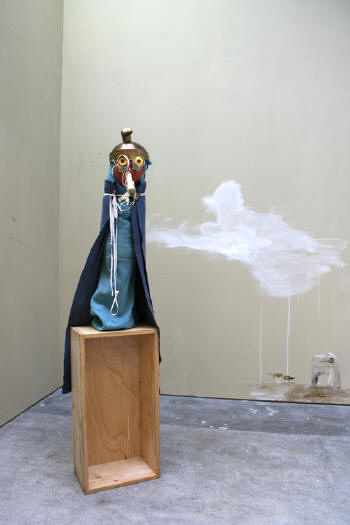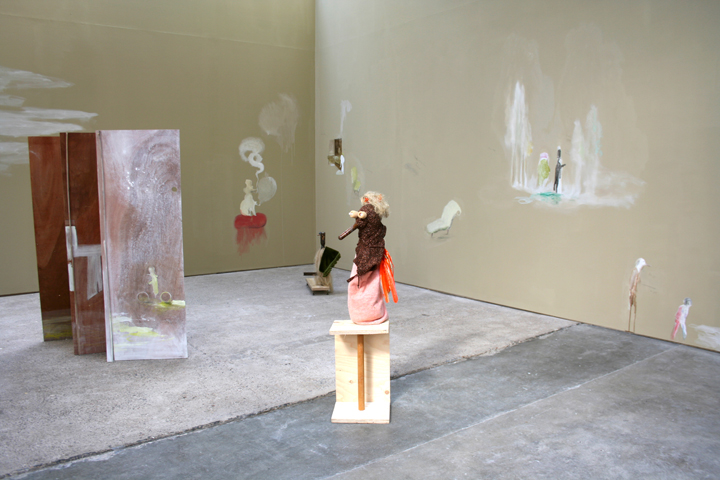|
|
| home | features | exhibitions | interviews | profiles | webprojects | gazetteer | links | archive | forum |
|
Edwina Ashton: No More Furniture Works|Projects, Bristol 19 February – 28 March 2010
Applied directly onto the gallery's walls, History Painting (from the invention of writing to the building of Stevenage), 2010, (detail right) features a peculiar assortment of whimsical scenarios looking like illustrations from some kind of demented fairy tale book. Watercolour, felt tip, pencil and biro all conspire in the creation of these ethereal scenes, which include, amongst other things, a poodle smoking a pipe, an elephant drinking tea and a pack of bizarre 'roaming beasts' that appear to be an unlikely cross between dogs, sheep and hedgehogs. Ashton's paint handling is loose and impromptu, combining delicate figurative elements with drips and smudges onto a ground of muddy beige. Nebulous white patches, suggestive of clouds, punctuate her vignettes, adding to their reverie, while snippets of spidery handwritten texts hint at larger undisclosed narratives.
These bizarre figures exude Ashton's trademark humour, yet also evoke an air of melancholy. Displayed alongside the sculptures are more painted scenes, this time applied to rickety, free-standing wooden screens. The most poignant of these is Lost in Stevenage, 2010, in which a lone figure rides a bicycle through a misty landscape. The work is situated near to one of Ashton's wall paintings depicting a cluster of architectural structures, perhaps representing Stevenage tower blocks. Although the significance of the Hertfordshire new town is unclear, the juxtaposition of these uncharacteristic works speak of hostile urban environments, which, along with the other sculptures, add to the sense of bleakness running throughout the show. This pathos also permeates Ashton's delicate works on paper, which, despite her whimsical approach, conjure notions of isolation and alienation. Displayed away from the main space in the gallery's office area, the drawings – which span several years – are arranged somewhat erratically in small clusters. Forlorn characters such as the dishevelled looking man in No Lions Nowadays, 2009, or the naively doodled figure of Bapageno, 2006, simultaneously evoke pity and revulsion. In New Bedroom, 2005, a loosely sketched figure sits awkwardly on a bed; another lonesome individual, perhaps contemplating their own existence or simply waiting for the rain to stop. A mysterious ambiguity pervades many of these equivocal works, which are still one of the strongest elements of Ashton's expanding practice.
David Trigg 8/3/10 |
|
|



